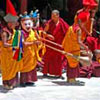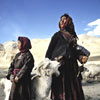Overlooking the town of Leh just on the slope of the Tesemo hill is the imposing multi-storey Leh Palace. This palace was built by a king named Tashi Namgyal in the 16th century about the same time as the great Potala Palace in Lhasa Tibet.
Bearing a passing similarity to the Potala Palace in Lhasa (Tibet), this nine-storey dun-coloured edifice is Leh’s dominant structure and architectural icon. It took shape under 17th-century king Singge Namgyal but has been essentially unoccupied since the Ladakhi royals were stripped of power and shuffled off to Stok in 1846. Today the sturdy walls enclose some exhibition spaces and a small prayer room, but the most enjoyable part of a visit is venturing up to the uppermost rooftops for the view.
Leh Palace is just above the old Leh city. Small, interesting gullies lead up to the base of the palace. From there the palace is just a few minutes climb.






